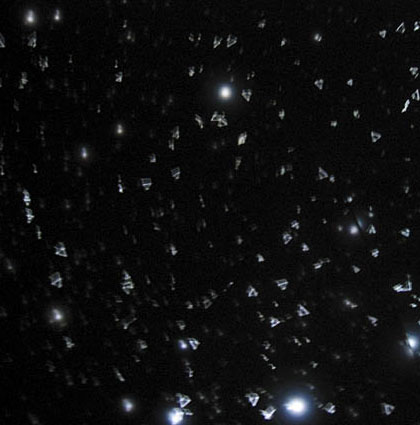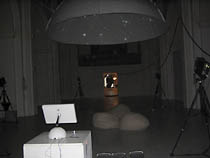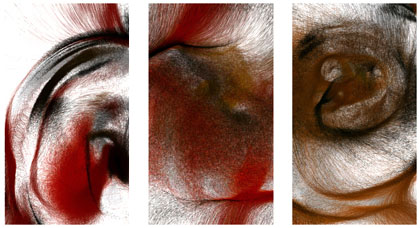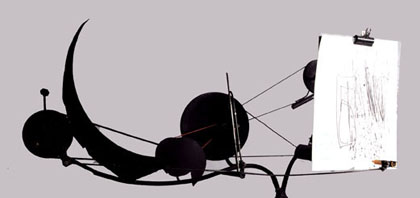|
[June 9th 2004]

Lise Autogena & Joshua Portway:
Black Shoals Stock Market Planetarium. Generative
installation. www.blackshoals.net
Special: Generative art
For a while now, we have explored the field of generative
art. In april 2004 this culminated in the exhibition 'Autopilot'
in kopenhagenshop as a part of the RADAR Festival. We definitely
have more to say about this art form.
In this special we continue our activities on the topic by gathering
new and old resources in one document - some of which have been
featured in our software art
special. Over time new articles on the subject will be added
to the list. Furthermore, you'll also find lots of links to interesting
generative art works. Text: Thomas Petersen.
Generative art is a widely used artistic method inserting an automated
system between the artist and the artistic expression. In a well-cited
text, Philip Galanter formulates the following definition: 'Generative
art refers to any art practice where the artist uses a system, such
as a set of natural language rules, a computer program, a machine,
or other procedural invention, which is set into motion with some
degree of autonomy contributing to or resulting in a completed work
of art.' (From 'What
is Generative Art? Complexity Theory as a Context for Art Theory',
Philip Galanter, New York University, 2003.)
Even though generative art is often reduced to merely a branch of
software art, Galanter's definition proposes a view that does not
restrict generative art strategies to its digital forms. There are
many traditions for basing art works on systems, procedures, and
instructions in most fields of art. John Cage, Yoko Ono and many
other conceptual artists have worked with procedural and instruction-based
work. The defining trait of generative art is rather that the artist
establishes a system, which can generate a number of possible forms
rather than one single finished form. The role of the artist is
to construct, initiate or merely select the frame of procedures
for the generation of possible expressions.
In its digital form, generative art is constructed from programmed
algorithms, which determine the path of a piece - in some cases
the pieces are autonomous to a degree that they seem alive. This
method puts a certain light on the nature of the art-making process,
because the tools acquire lives of their own. In these cases, the
constructions of art-making systems substitute the making of static
forms.
In other cases the systems rely on input from human actors or information
feeds. One example is Lisa Autogena and Joshua Portway's Black
Shoals Stock Market Planetarium, which was exhibited recently
at Nikolaj Udstillingsbygning in Copenhagen (see above illustration).
The project is a live representation of the world's stock markets.
Whenever stock of a certain value is traded, the the light of the
stars change. A colony of artificial life forms feed off this star
light and form an evolving ecology. The piece is set up as an immersive
installation letting the spectator lie down and contemplate the
starry skies of global finance.
Artificial texts with relevance
to generative art:
[September 20th]
Thomas Petersen: Generative Art Now. An Interview with Marius Watz
[May 13th 2005]
Emil Bach Soerensen: An Experience with Your Body in Space! Interview with Camille Utterback
[September 6th 2004]
Thomas Petersen & Kristine
Ploug: 'Generative art is as old as art'. An interview with Philip
Galanter
[April 26th 2004]
Photos from Diffus
generative art seminar and site launch.
[April 14th 2004]
Photos
from Autopilot exhibition.
[March 23d 2004]
Thomas
Petersen: "Computer Code as Art Material". Interview with
Pablo Miranda Carranza, Thor Magnusson and Ole Kristensen.
[March 11th 2004]
Anne Roelsgaard Obling: Interview
with Lise Autogena
(Danish only)
[February 29th 2004]
Press
release: Kopenhagen.dk/net.art curates generative art exhibition
[November 19th 2003]
Kristine
Ploug: "I am never sure what it will do ... until I run it.
An Interview with John F. Simon Jr."
[October 20th 2003]
Sebastian
Campion: "Code. In Conversation with Casey Reas"
Digital generative art works:

Tom Betts & Joe Gilmore:
Rand()%: http://www.r4nd.org.
Rand()% is an internet radio station streaming generative
music.

Adrian Ward: Autoshop and Autoillustrator.
http://www.signwave.co.uk/products/.
 
Lise Autogena & Joshua Portway:
Black Shoals Stock Market Planetarium. Generative
installation. www.blackshoals.net.

Cornelia Sollfrank: Net.art
generator. http://www.obn.org/generator.

Casey Reas:
MicroImage, generative installation. Triptych of software. Different
forms emerging out of the same software code. Running on plasma
screens at the Ars Electronica festival. http://groupc.net/work.php?section=software&work=microimage_s.

John F. Simon Jr.: Complexcity.
http://www.numeral.com.
Non-digital:

Jean Tinguely: Metamatic (1959->).

Hans Haacke: Condensation Cube, 1963-65.

Yoko Ono: Smoke Painting (instructions),
1961.
A selection of previously featured work
Marius Watz: Drawing Machine 1-12.
http://odin.dep.no/tegnemaskin/index_e.html
Stanza: Biocity.
http://www.stanza.co.uk/biocity/index.html
Pablo Miranda Carranza: ArchiKluge. http://www.armyofclerks.net/ArchiKluge/index.htm
Thor Magnusson & Birta Thrastardottir.
http://www.ixi-software.net
Ole Kristensen: Flyt dig.
http://ole.kristensen.name/flytdig
Other links
http://www.generative.net
http://www.runme.org/categories/+generative_art/
http://www.artificial.dk/articles/softwareintro.htm
|